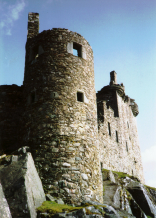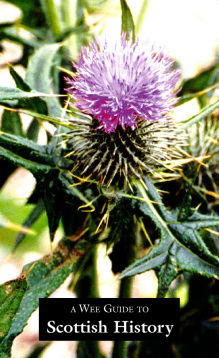The Making of the Kingdom
400 Picts & Britons
With the withdrawal of the Roman legions, the Picts controlled the east and north, and were divided into the north Picts, and the south Picts in Galloway. The north Picts may have had their capital at Inverness, but also had important centres at Burghead, Urquhart – later used as a castle in medieval times – Dunkeld, Scone, Forteviot and Abernethy. The Picts spoke Britonnic Gaelic, akin to the Welsh language, and used matrilineal descent of inheritance for their kings, where the line descended through the mother.
Strathclyde was occupied by the Britons, whose kingdom at one time stretched from Cornwall, through Wales and Cumbria, to Dumbarton. The Britons also spoke a language related to Welsh.
These kingdoms, and the later realms of the Scots and Angles, spent much of their time, and vigour, fighting each other.
430 St Ninian & St Patrick
By 430, St Ninian, a Briton, had been active in Galloway, converting the south Picts to Christianity, probably to a Roman form of worship. He founded a religious house, Candida Casa – so-called because the walls of his church were whitewashed – at Whithorn. Ninian died in 432. Whithorn was a place of pilgrimage in medieval times, and ruins of a 12th-century cathedral church and priory survive. St Ninian’s Cave, south-west of Whithorn, is traditionally associated with the saint.
In the same year, St Patrick, said to have been born at Kilpatrick, near Dumbarton, converted many of the Irish to Christianity
500 The coming of the Scots
It was in 503 that many Scots left Ireland and settled in Argyll – they had, however, apparently been doing so for years: Pictish influence never appears to have been strong here. The Scots had raided along the coasts of the south-west for many years. Their kingdom was known as Dalriada, and their king, Fergus MacErc, reputedly brought with him the Stone of Destiny. Dunstaffnage, later used as the site for a medieval castle, and Dunadd, an impressive hill fort, were two of their strongholds. About this time the Scots became Christians.
547 Bernicia & the kingdom of the Angles
The Angles held much of the east of England by 547, and King Ida became the ruler of Bernicia, which included lands from the Firth of Forth to the River Tees, in the north of England. His capital was at Bamburgh – the site of which is occupied by a medieval castle – in Northumberland. The Angles were pagans.
563 St Columba & St Mungo
St Columba, a Scot from Ireland, settled at Iona, bringing with him the Celtic form of the Christian church. He converted the north Picts, ruled by King Brude from a stronghold at or near Inverness, and is said to have confronted a serpent in Loch Ness, the first mention of a monster there. Iona became the centre of Christianity in Scotland. The present restored abbey and nunnery date from medieval times, but early Scots, Irish and Norse kings are reputedly buried here.
About the same time, St Mungo, who is also known as Kentigern, converted the Britons of Strathclyde, and Glasgow Cathedral is dedicated to him. The Cathedral is mainly medieval, but is built over Mungo’s tomb.
600 Conversion of the Angles to Christianity
St Aidan, a missionary from Iona, converted the Angles of Bernicia to Christianity, the work being continued by St Cuthbert. Lindisfarne, in Northumberland, became a great religious centre, and the ruins of a later priory
are in the care of English Heritage and open to the public.
663 The Celtic Church & the Synod of Whitby
The Synod of Whitby was held, in Yorkshire in England, at which the ritual and beliefs of the Roman Church, particularly the dating of Easter, were asserted over the practices of the Celtic Church. The Roman Church came to dominate the whole of Scotland.
685 Battle of Nechtansmere
The Angles of Bernicia tried to push their border far to the north, but were defeated by the Picts at the Battle of Nechtansmere, near Forfar. Their king, Egfrid, was slain with much of his army. The carved stones at Aberlemno, which are near Nechtansmere, probably commemorate this battle. The Picts extended their influence south again, and dominated the Scottish kingdom of Dalriada.
733 St Andrew, Patron Saint of Scotland
Acca, Bishop of Hexham, brought the relics of St Andrew to Fife, where there was already a religious settlement, probably founded by St Rule, a disciple of Columba, about 590. St Andrews Cathedral, now a fragmentary ruin, was founded on the site of this early community. The flag of Scotland, the white saltire on a blue background, represents the crucifixion of St Andrew on an ‘X’ shaped cross. One story is that the cross appeared in the sky before a victory in 735 by the Picts over the Northumbrians, and this was attributed to Andrew’s intercession.
793-826 Lindisfarne & Iona attacked
The Norsemen sacked Lindisfarne in 793, and looted Iona in 795. These attacks forced Iona to be abandoned, and the monks moved to Dunkeld in 826, which was safer from Norse long ships. The partly ruined Cathedral at Dunkeld is built on the site of an earlier church.
The Norsemen raided all along the coasts, and greatly weakened the northern kingdoms. They settled in Orkney and Shetland, and parts of the northern mainland and the western isles, forming a powerful Norse province.
843-59 Union of Scots & Picts – Kenneth MacAlpin
Kenneth MacAlpin united the crowns of the Scots and the Picts. What is unusual about this union is that at this time the Picts had the upper hand in the fighting between the two peoples. The union seems to have been peaceful. Kenneth had a claim to the throne of Picts through his mother, a Pictish princess, although he reputedly secured his position by slaughtering all his rivals. Nearly all Pictish culture and language was lost.
Kenneth moved from fortresses at Dunadd and Dunstaffnage to Dunkeld, Scone and Forteviot, which were much safer from Norse attack.
859-900 Donald I, Constantine I, Aed, Eochaid & Giric, Donald II
Donald I, Kenneth’s brother, succeeded to the throne, but died in 863. He was followed by Constantine I, who was slain in battle against the Norsemen in 877; and then Aed, who was killed by his cousin, Giric, in 878. Eochaid and Giric ruled as joint monarchs, but in 889 both kings were deposed, and Giric was killed in a siege at the fortress of Dundurn. They were succeeded by Donald II, but he was poisoned in 900.
900-943 Constantine II & the Battle of Brananburgh
Constantine II came to the throne in 900 and ruled for 43 years, a very long reign indeed for the time. The kingdom of Strathclyde had become dependent on the Scots, and in 908 the throne passed to Constantine’s brother. Constantine spent much of his reign fighting the Norse and driving them from his realm.
However, in 937, Constantine and the Scots, and an army of Irish and Northumbrian Norsemen and Britons, were defeated by Athelstane, King of the Saxons, with great slaughter of the Scots and their allies. The southern borders of the kingdom of Scots were attacked, and in 943 Constantine resigned his throne to his cousin, Malcolm I.
943-1005 Malcolm I, Indulf, Duff, Culen, Kenneth II, Constantine III, Kenneth III
In return for land, Malcolm I apparently became a vassal of the English king, Athelstane. However, in 950 he captured Northumberland, but was killed in a battle with the men of Moray. He was followed by Indulf, who was probably killed about 962; then Duff, who was slain in Moray in 967; then Culen, who was put down by the Britons in Lothian in 971.
The reign of Kenneth II was relatively peaceful, until he was poisoned in 995 by Finella, whose son had been murdered by Kenneth. It is during his reign that the thistle traditionally became associated with Scotland. At a battle in 973 at Luncarty, the sleeping Scottish forces were woken when the Norse enemy stumbled into a patch of thistles. The first recorded use of the thistle, however, is on coins in the reign of James III in 1470.
Constantine III came to the throne in 995, but was murdered in 997. He was followed by Kenneth III, who was slain in 1005 by Malcolm II.
Dynastic fighting, failed invasions, and Norse raids weakened the kingdom, and by 1005 the Scots had lost control of Lothian and Strathclyde, the north and west were held by the Norsemen, and Moray and other areas were in rebellion.
1005-34 Malcolm II & the Battle of Carham
Malcolm II came to the throne in 1005, and in 1010 he defeated a Norse army at Dufftown and secured his northern border, by a combination of fighting and marrying off his daughter to the Norse Jarl of Orkney. Turning his attention to the south, Malcolm and the Scots, aided by Owen the Bald of Strathclyde, defeated the Northumbrians, under King Uhtred, at Carham, in 1018, occupying Lothian. Owen was killed at the battle and Strathclyde was absorbed into the kingdom of Scots – which more or less assumed its present southern border.
Malcolm II ensured Duncan’s succession by slaughtering other claimants.
1034-58 Duncan & Macbeth
Duncan came to the throne in 1034, but was, in his turn, slain in battle by Macbeth – not in his bed with a bloodied dagger as described by Shakespeare. Macbeth ruled well, strengthening the kingdom sufficiently to make a pilgrimage to Rome in 1050. However, in 1057 he was killed at Lumphanan by Malcolm Canmore – Canmore meaning big head – son of Duncan, who was helped by Edward the Confessor of England. Malcolm Canmore – Malcolm III – was named king. Lulach the Fool, a distant relation of Macbeth, was set up as a rival claimant to the throne, but was slain by Malcolm in 1058.
© Martin Coventry 2018









